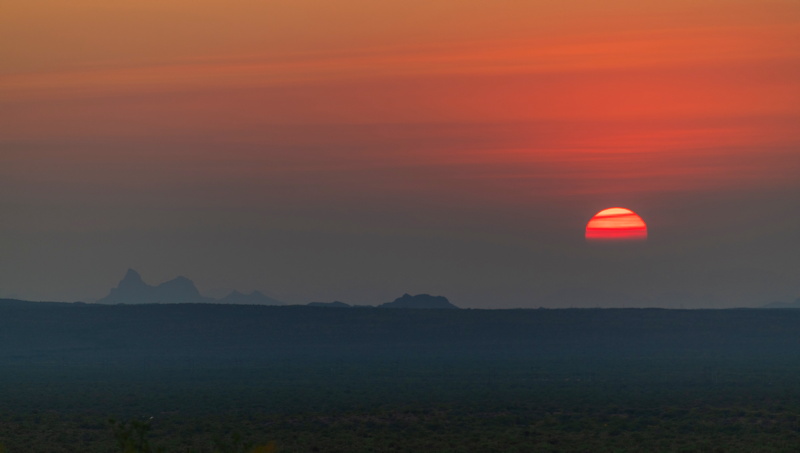Trifid Nebula HA-OIII, Observing Galaxy Trios
Posted: 8 September 2020
|
Open: Monday, 7 September 2020, 1827 MST Temperature: 89°F |
Session: 1517 Conditions: Mostly clear, very breezy |
Equipment:
12" f/8 LX600 w/StarLock
2" 24mm UWA eyepiece
Filter Slider System; HA, OIII, SII filters
Camera:
D850 DSLR
After opening the dome I relaxed on the observatory patio bench while waiting (hoping) for the strong breezes to die down.
As sunset approached, the western sky showed the effects of the California wildfires smoke.
1838 MST: Picacho Peak (31 miles away) and the setting Sun taken with the D850 DSLR (f/5.6, 1/400sec, ISO 400, FL 300mm).

1841 MST: sunset (time approximate).
1900 MST: back inside the observatory. Still breezy.
1901 MST: LX600 ON, StarLock OFF, High Precision OFF.
Viewed Jupiter and three Moons, then Saturn and four moons, 102X. Seeing was not very good. I decided to defer planet imaging to a future session.
Slewed the 12" telescope to M20 (Trifid Nebula), my planned first imaging target of the night using the Optolong Hydrogen-Alpha, Oxygen III, and Sulfur II filters, conditions permitting. The nebula was not yet visible in the bright twilight sky.
1910 MST: back to relaxing on the bench. Still breezy.
1924 MST: observed a nice bright meteor at the Zenith. It was moving southwest to northeast through the constellations of Lyra and Cygnus. The head was bright orange, with a nice trail behind it.
1953 MST: back inside the observatory. Calm now.
Viewed M20 (Trifid Nebula), 102X.
1956 MST: StarLock ON.
StarLock autoguiding was good.
1958 MST: StarLock OFF.
Mounted the D850 DSLR at prime focus using the Starizona Filter Slider System, focused on the star Antares with the HA filter in place using a Bahtinov Mask, then locked the 12" mirror.
2010 MST: StarLock ON.
Did some framing test images of M20 (no filter). Then did a series of StarLock autoguided images (HA 3 minutes, OIII 3 minutes, SII 12 minutes, ISO 6400, White Balance 5560K). This image is a merge of the HA and OIII images (the SII did not add anything useful to the image).

Autoguiding was not always good as strong breezes had returned. Decided to end imaging for this session.
2037 MST: StarLock OFF.
On my previous report I mentioned that I had experienced an increasing number of random shutter triggers with the Vello ShutterBoss wireless receiver on my D850 DSLR. I replaced the receiver batteries and had no random triggers this session. There had been no "battery low" indication on the receiver, but the older batteries were 2+ years old and were the original "off-brand" batteries that came with the ShutterBoss.
A friend recently gave me some old astronomy books. Among the books was a five volume set of the Webb Society Deep-Sky Observer's Handbooks: Double Stars, Planetary and Gaseous Nebulae, Open and Globular Clusters, Galaxies, and Clusters of Galaxies. The books were published in 1979, 1980, 1981, and 1982 and are out-of-print now. As I began to read "Volume 1: Double Stars" I wondered if the Webb Society still existed. It does: Webb Deep-Sky Society. On their site there are some free publications, including Miles Paul's "Atlas of Galaxy Trios". I downloaded the Atlas. Although most of the galaxies listed are faint (Mag. +14 to +16) I decided to try to observe some of them. This session I observed the following Galaxy Trios, 102X:
NGC5981 NGC5982 NGC5985
NGC6956 UGC11620 UGC11623 (only saw NGC6956)
NGC7273 NGC7274 NGC7276 (only saw NGC7274)
NGC7769 NGC7770 NGC7771
2116 MST: ended Galaxy Trios observing.
2117 MST: LX600 OFF.
2130 MST: took a Sky Quality reading using a Unihedron SQM-L.
|
Close: Monday, 7 September 2020, 2133 MST Temperature: 82°F |
Session Length: 3h 06m Conditions: Mostly clear, breezy, SQM 20.92 |
Comments are welcome using Email. Twitter users can use the button below to tweet this report to their followers. Thanks.
Cassiopeia Observatory Home Page
Copyright ©2020 Michael L. Weasner / mweasner@me.com
URL = http://www.weasner.com/co/Reports/2020/09/08/index.html
